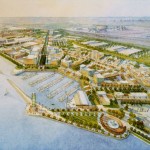The Inquirer has published a smart essay today about the conversion of abandoned properties to new uses, what the University of Pennsylvania’s Mark Alan Hughes and Elise Harrington call “the arbitrage of legacy assets.” They cite the Philadelphia Navy Yard as a prime example of how tapping hidden value in underutilized or abandoned sites can generate new activity and wealth. They plan to further elaborate their thesis through a conference planned for October under the title “Unlocking Value from Regional Energy Assets.”
prime example of how tapping hidden value in underutilized or abandoned sites can generate new activity and wealth. They plan to further elaborate their thesis through a conference planned for October under the title “Unlocking Value from Regional Energy Assets.”
Coincidentally, an essay has appeared in the May, 2013 issue of the Journal of Planning History calling for a parallel approach by urging the creative reuse of neglected industrial sites in Detroit. In their approach to adaptive reuse, Brent Ryan and Daniel Campo challenge contemporary trends to either glory in the extent of these ruins—what some have come to call ruin porn—or simply to clear land without seeking to capitalize on previous investments in existing structures or their associated infrastructures. Ryan further explores the challenges to post-industrial planners in his 2012 book, Design After Decline: How America rebuilds shrinking cities.
In yet another affirmation of the promise of post-industrial redevelopment, Temple University’s Carolyn Adams has made the case for reinvestment in older industrial suburbs where previous commitments to mass transportation and waterfront access make land reuse attractive for a variety of purposes in environmentally sustainable ways. Her essay appears in the 2012 volume, Nature’s Entrepot: Philadelphia’s Urban Sphere and its Environmental Thresholds, edited by Brian Black and Michael Chiarappa. It’s not accidental that these essays have appeared at roughly the same time. City planners are increasingly conscious about environmental costs. Adaptive reuse has been popular for some time, but it can be used even more creatively on industrial districts, where the challenges might be great but the returns could be surprisingly rewarding.